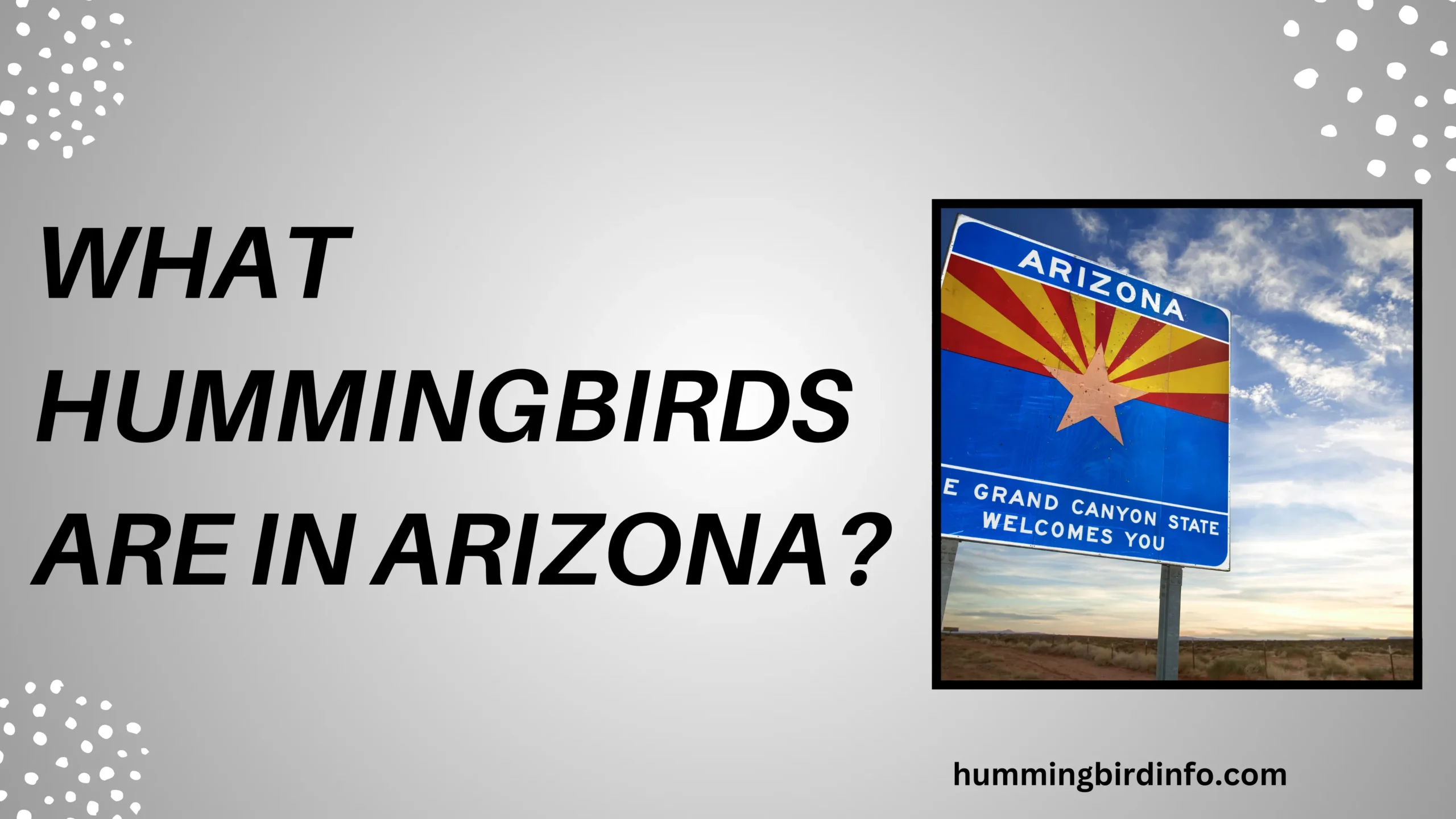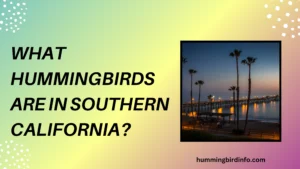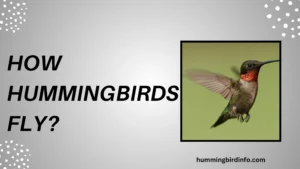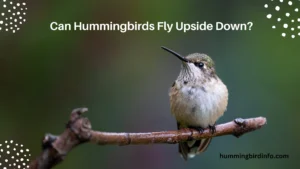Contents
- 1 The Glittering Wings of Arizona
- 2 The Regular Residents and Common Visitors
- 3 Less Common and Migratory Visitors
- 4 Arizona’s Unique Hummingbird Ecology
- 5 Attracting and Observing Hummingbirds in Arizona
- 6 Conclusion:
- 7 FAQs:
- 8 How many hummingbird species are found in Arizona?
- 9 When is the best time to see hummingbirds in Arizona?
- 10 Do any hummingbirds live in Arizona year-round?
- 11 Which part of Arizona has the most hummingbird diversity?
- 12 Can I attract hummingbirds with feeders in the desert?
- 13 Are hummingbirds important for Arizona’s ecosystem?
- 14 Why are so many species seen in Arizona?
The Glittering Wings of Arizona
Arizona is a land of contrasts and wonders—where towering saguaros stand like sentinels over golden sands and lush riparian canyons hide unexpected life. Amid this rugged beauty, a tiny spectacle takes flight.
Hummingbirds—shimmering flashes of emerald, violet, and ruby—dart through the desert air like living jewels, enchanting all who are lucky enough to spot them. These birds are more than just beautiful; they are a symbol of survival, resilience, and nature’s intricate balance.
What makes Arizona so special for hummingbirds? It’s not just the warm weather. The state offers an incredible blend of diverse habitats, from desert valleys to cool forested mountain slopes.
It also sits right along a major migratory flyway, turning it into a critical stopover for species journeying between Mexico and the northern U.S.
In fact, Arizona is home to more species of hummingbirds than any other U.S. state outside of Texas—some permanent residents, others just passing through. Each species brings its own story, colors, and calls.
In this post, we’ll explore the key hummingbird species you can find in Arizona—both year-round locals and fleeting visitors. We’ll cover how to identify them, where they live, when they arrive, and how to attract them to your own yard.
Along the way, you’ll gain a deeper understanding of how these tiny pollinators support Arizona’s wildflowers and what makes them a true desert treasure. Whether you’re a seasoned birder or simply curious, this guide will help you appreciate one of Arizona’s most captivating natural wonders.
The Regular Residents and Common Visitors
Anna’s Hummingbird (Calypte anna):
The Year-Round Urbanite
The male Anna’s Hummingbird wears a dazzling rose-red gorget and crown, with a bright green back and grayish belly.
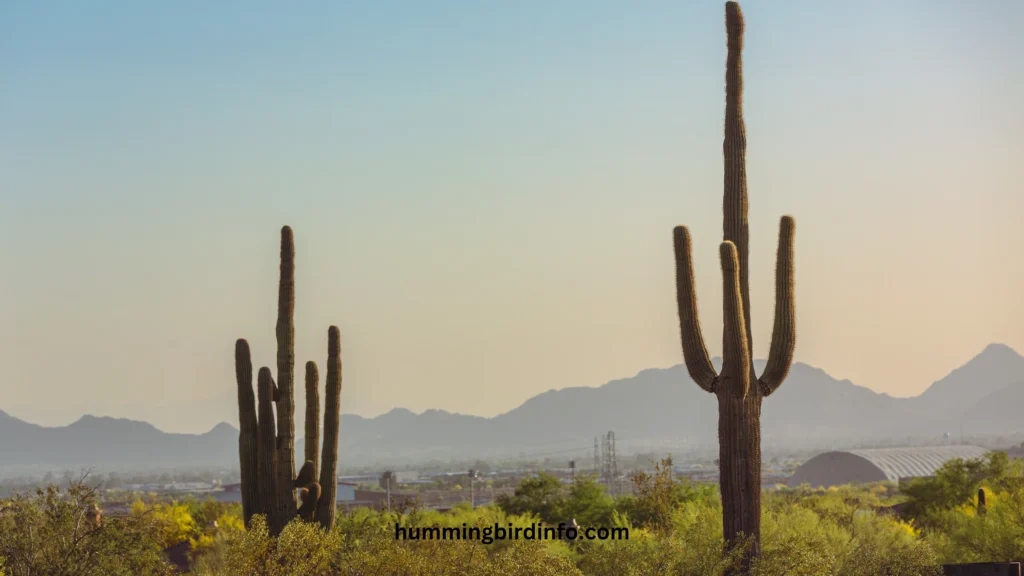
Females are more subtle, with green feathers and a speckled throat. These birds have adapted brilliantly to Arizona’s urban spaces.
They live year-round in cities and suburbs, feeding on both native plants and garden flowers. You’ll often see them hovering around feeders or perching boldly on twigs.
Males perform dramatic courtship dives that end in a loud “squeak”—a sound made not by their voice, but by their tail feathers. Their early nesting season begins in winter, often in tree branches close to human homes.
Costa’s Hummingbird (Calypte costae):
The Desert Specialist
This species is built for the arid heart of Arizona. The male flashes a brilliant violet crown and gorget, flaring outward like a beard. The female has softer tones but sports a similar green back.
They thrive in desert scrub, chaparral, and dry washes, especially in southwestern regions of the state. Their nesting season aligns with desert wildflower blooms, ensuring ample nectar.
The male’s high-pitched courtship song is more insect-like than musical, but it’s unique and unmistakable. You’ll find them near ocotillos and agaves, where they often nest low to the ground.
Rufous Hummingbird (Selasphorus rufus):
The Fiery Migrant
Small but fierce, the male Rufous boasts a bright orange-red gorget and rust-colored body. The female has more green but retains those warm, rusty accents.
They’re long-distance migrants, flying from Mexico to Alaska and back, passing through Arizona during spring and late summer. They prefer mountain meadows and forest edges.
Known for their aggressive nature, they defend feeders and flowers with surprising intensity. Keep an eye out in March–April and again in July–August for their fiery presence.
Broad-billed Hummingbird (Cynanthus latirostris):
The Riparian Beauty
One of Arizona’s most vibrant birds, the male Broad-billed stuns with a blue throat, emerald body, and red bill. Females have a simpler look but still sport a reddish-tipped bill.
They favor riparian woodlands and shady canyons in southeastern Arizona. Look near sycamore-lined streams and willow groves for their unmistakable shimmer.
Broad-bills often perch low and visibly, making them easier to photograph and observe than other hummingbirds.
Black-chinned Hummingbird (Archilochus alexandri):
The Widespread Visitor
A common sight across the state, the male Black-chinned has a black throat with a hidden purple sheen, plus a clean white collar. The female is pale below with a green back.
They arrive in spring and nest throughout Arizona, from deserts to mountains, as long as there’s water nearby. These birds migrate to Mexico in the fall.
They’re modestly territorial and adaptable, often nesting in backyards and reliably visiting feeders.
Lucifer Hummingbird (Calothorax lucifer):
The Tassel-Throated Gem
Rare and striking, the male Lucifer wears a magenta, forked gorget that juts out like streamers. Females are buff-colored below with green above.
They inhabit rocky slopes and canyon edges in southeastern Arizona, often near agave patches.
Their unique fluttering courtship is easy to spot for those who venture into remote desert canyons during late spring and early summer.
Less Common and Migratory Visitors
Violet-crowned Hummingbird (Amazilia violiceps)
The violet-crowned hummingbird has a bright white belly, green body, and a rich purple-blue crown. Its red bill is striking in flight.
You’ll find them mainly in southeastern Arizona, especially in riparian woodlands with sycamores. They typically appear in summer months.
They’re not aggressive and may share space with other hummingbirds.
White-eared Hummingbird (Hylocharis leucotis)
A forest-dweller, this bird shines with green plumage and a blue throat, plus a white stripe behind the eye.
It prefers pine-oak forests and cool canyons, especially at high elevations.
This species is seasonal, appearing mostly in summer, and is a favorite among birders for its rarity and beauty.
Broad-tailed Hummingbird (Selasphorus platycercus)
The male has a rosy-pink gorget and buzzing wings that hum in flight. Females are green-backed with rusty sides.
They migrate through Arizona, especially higher elevations and mountain meadows.
Their wing sounds are key for ID and make them stand out from others.
Other Vagrants
Rare species like the Berylline and Buff-bellied Hummingbird show up in Arizona occasionally, blown off course from Mexico.
While not regulars, they’re highlights for expert birders and often show up during summer.
Watch rare bird alerts or eBird for recent sightings.
Arizona’s Unique Hummingbird Ecology
Arizona’s plant diversity plays a big role in attracting hummingbirds. Species like ocotillo, penstemons, and salvias produce nectar-rich blooms tailored to hummingbird beaks.
Many hummingbirds have co-evolved with these plants, meaning flower shape and blooming time sync with hummingbird behavior.
Even agaves and desert honeysuckle serve as key food sources in dry months.
The state’s location on a major migratory route boosts its hummingbird count. Birds heading to and from Mexico and Central America stop in Arizona for food and rest.
This makes the state a migration hotspot, especially during spring and late summer.
Birders come from around the country to witness this seasonal magic.
Arizona also offers unique vertical habitats—from deserts under 1,000 feet to alpine forests above 10,000 feet.
Each elevation supports different hummingbird species, which leads to more diversity than in most states.
Even small areas can host multiple species based on elevation, vegetation, and water access.
Water is also critical. In a dry climate, hummingbirds need shallow water sources, like misters, fountains, or shaded puddles.
Many birds prefer areas with both flowers and water, especially in peak heat.
Creating these small oases can bring more birds to your yard or observation site.
Attracting and Observing Hummingbirds in Arizona
Use a 1:4 sugar-water mix in feeders—no dye, just clean water and plain white sugar.
Keep feeders clean and cool, especially in the hot Arizona sun. Change nectar every 2–3 days.
Put feeders up early in spring and again in late summer to catch both waves of migrants.
Grow native flowers like desert honeysuckle, ocotillo, salvia, and penstemon.
These not only feed hummingbirds but support Arizona’s whole ecosystem.
Add flowering shrubs and vines to create a layered habitat.
Consider shallow water features or misters—especially helpful during dry months.
Place them near flowers or feeders for maximum hummingbird traffic.
Even small patios can host multiple birds with the right setup.

The best times for watching are early morning and late afternoon.
Visit canyons, mountain meadows, and desert washes for a wide variety of species.
Southeastern Arizona, including places like Madera Canyon and Ramsey Canyon, are must-visits.
Join citizen science projects like eBird or Project FeederWatch.
Logging sightings helps researchers understand migration, breeding, and range shifts.
Your backyard notes could contribute to hummingbird conservation!
Conclusion:
Arizona is a jewel box of hummingbird diversity, unmatched in the United States. Its blend of climates, habitats, and floral resources creates a haven for these radiant birds.
From the fiery Rufous to the violet-crowned travelers, each species adds a spark of life to this desert land.
Whether permanent residents or fleeting guests, their stories are woven into Arizona’s natural rhythm.
These tiny creatures are not just beautiful—they’re essential. They pollinate wildflowers, support native ecosystems, and offer a glimpse into nature’s delicate design.
By protecting their habitats and planting native flora, we help sustain both birds and blossoms.
Every feeder hung, every flower grown, is a small act of conservation.
So the next time you hear the whirr of tiny wings, pause and marvel.
Arizona’s hummingbirds are resilient, radiant, and remarkable—living proof that nature’s smallest beings often carry the biggest impact.
Let them inspire awe, curiosity, and a deeper commitment to the wild places we all call home.
FAQs:
How many hummingbird species are found in Arizona?
Arizona hosts more than 15 species, with around 6–8 common ones seen regularly depending on the season.
When is the best time to see hummingbirds in Arizona?
The best times are during spring and fall migration, especially March–May and July–September.
Do any hummingbirds live in Arizona year-round?
Yes, Anna’s Hummingbird and Costa’s Hummingbird can be seen in parts of Arizona throughout the year.
Which part of Arizona has the most hummingbird diversity?
Southeastern Arizona, especially areas like Madera Canyon and Patagonia, is known for the highest diversity.
Can I attract hummingbirds with feeders in the desert?
Absolutely! Just provide clean sugar-water and plant native nectar-rich flowers.
Are hummingbirds important for Arizona’s ecosystem?
Yes, they are key pollinators for many native plants, especially in desert and riparian zones.
Why are so many species seen in Arizona?
Arizona’s climate, elevation range, and location on a migration corridor make it ideal for hummingbirds.

